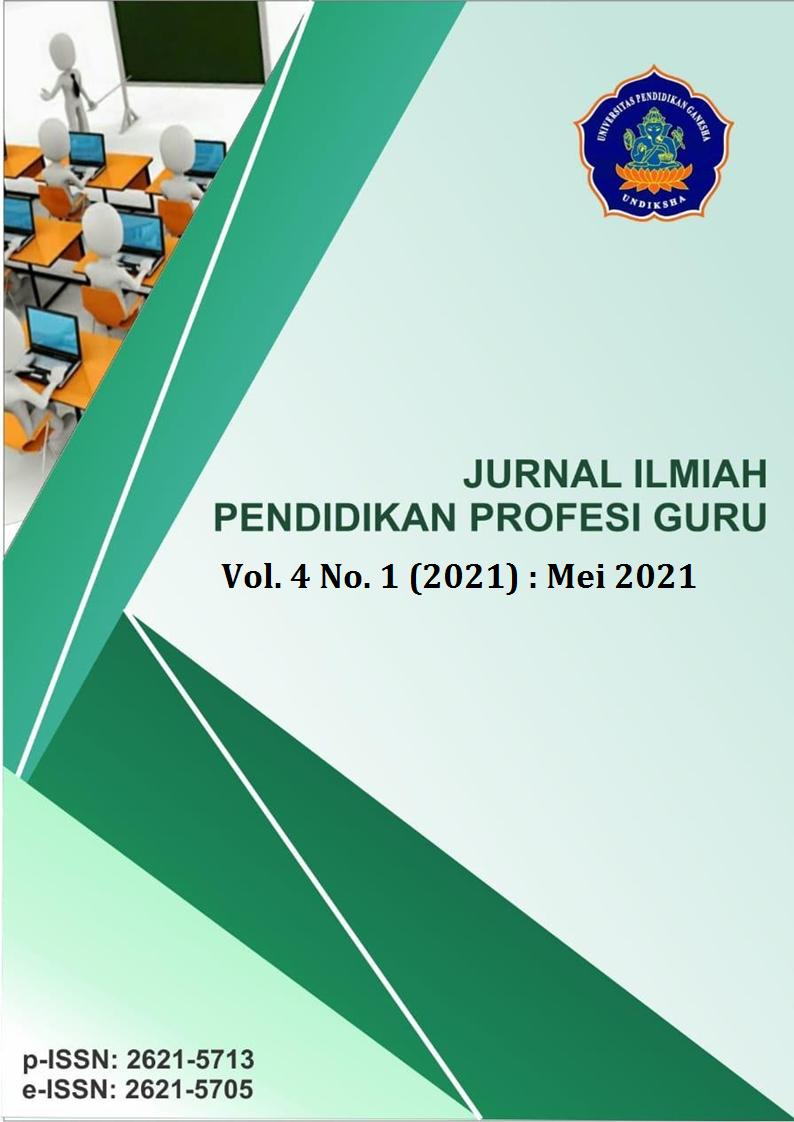Pengembangan Instrumen Asesmen Berbasis Literasi Sains Tentang Materi Sistem Ekskresi dan Sistem Pernapasan
DOI:
https://doi.org/10.23887/jippg.v4i1.29860Keywords:
Assesment, Scientific LiteracyAbstract
The 2013 curriculum which focuses on improving scientific literacy, assessment is an integral part of the science learning process. However, based on the results of measurements carried out by PISA (Program for International Student Assessment), Indonesian scientific literacy is still relatively low. This study aims to produce an assessment instrument based on scientific literacy on the excretory system and respiratory system material. This research is Research and Development using the Plomp development model which consists of the initial investigation stage, the development stage or the prototyping stage, and the assessment stage. The subjects of the small-scale research product test were 9 students, and the field trial was 32 students. The results showed that the average value of the logical validity of the instrument was 87,23% which was declared very valid and the empirical validity value was 80,00%. The results of the practicality test of the assessment instrument by teachers scored 89,52% and by students 88,43%. The reliability of the scientific literacy-based assessment instrument shows a very high category with a reliability value of 0,93, 80 % questions with moderate difficulty criteria and 66,00% questions with good discriminating power. So, it can be concluded that the scientific literacy-based assessment instrument for the excretory system and respiratory system material can be declared very valid, very practical, and the reliability of the questions is very high.
References
Abdullah, D. I., Z, M., & H, S. (2015). Keefektifan model pembelajaran problem based learning bernuansa etnomatematika terhadap kemampuan pemecahan masalah siswa kelas VIII. Unnes Journal of Mathematics Education., 4(3). https://doi.org/10.15294/ujme.v4i3.9056.
Agustika, G. N. S. (2018). Pengembangan konstruksi dan validasi tes konsep dasar Matematika. Journal of Education Technology, 2(1), 40–44. https://doi.org/10.23887/jet.v2i1.13805. DOI: https://doi.org/10.23887/jet.v2i1.13805
Andriani, N., Saparini, S., & Akhsan, H. (2018). Kemampuan Literasi Sains Fisika Siswa SMP Kelas VII Di Sumatera Selatan Menggunakan Kerangka PISA (Program for International Student Assesment). Berkala Ilmiah Pendidikan Fisika, 6(3), 278–291. https://doi.org/10.20527/bipf.v6i3.5288. DOI: https://doi.org/10.20527/bipf.v6i3.5288
Ardianto, D., & Rubini, B. (2016). Literasi sains dan aktivitas siswa pada pembelajaran IPA terpadu tipe shared. USEJ - Unnes Science Education Journal, 5(1), 1167–1174. https://doi.org/10.15294/usej.v5i1.9650.
Bashooir, K., & Supahar, S. (2018). Validitas dan reliabilitas instrumen asesmen kinerja literasi sains pelajaran Fisika berbasis STEM. Jurnal Penelitian Dan Evaluasi Pendidikan, 22(2), 168–181. https://doi.org/10.21831/pep.v22i2.20270. DOI: https://doi.org/10.21831/pep.v22i2.20270
Charmila, N., Zulkardi, Z., & Darmawijoyo, D. (2016). Pengembangan Soal Matematika Model Pisa Menggunakan Konteks Jambi. Jurnal Penelitian Dan Evaluasi Pendidikan, 20(2), 198–207. https://doi.org/10.21831/pep.v20i2.7444. DOI: https://doi.org/10.21831/pep.v20i2.7444
Gormally, C., Brickman, P., & Lut, M. (2012). Developing a test of scientific literacy skills (TOSLS): Measuring undergraduates’ evaluation of scientific information and arguments. CBE Life Sciences Education, 11(4), 364–377. https://doi.org/10.1187/cbe.12-03-0026. DOI: https://doi.org/10.1187/cbe.12-03-0026
Inteni, K. A. S., Candiasa, I. M., & Suarni, N. K. (2013). Pengembangan instrumen tes objektif pilihan ganda yang diperluas berbasis web untuk mata pelajaran TIK kelas XI SMAN di Kabupaten Karangasem. Jurnal Penelitian Dan Evaluasi Pendidikan, Vol 3(5). http://119.252.161.254/e-journal/index.php/jurnal_ep/article/view/1039/787.
Khery, Y., Nufida, B. A., Suryati, S., Rahayu, S., & Aini, M. (2019). Pemahaman Mahasiswa tentang Hakikat Sains dalam Pembelajaran menggunakan Model Pembelajaran Mobile-NOS. Prisma Sains : Jurnal Pengkajian Ilmu Dan Pembelajaran Matematika Dan IPA IKIP Mataram, 7(2), 169–179. https://doi.org/10.33394/j-ps.v7i2.1771. DOI: https://doi.org/10.33394/j-ps.v7i2.1771
Lestari, D., & Setyarsih, W. (2020). Kelayakan Instrumen Penilaian Formatif Berbasis Literasi Sains Peserta Didik Pada Materi Pemanasan Global. Ipf : Inovasi Pendidikan Fisika, 09(03), 561–570. https://doi.org/10.26740/ipf.v9n3.p561-570. DOI: https://doi.org/10.26740/ipf.v9n3.p561-570
Mijaya, N. P. A. P., Sudiatmika, A. A. I. A. R., & Selamet, K. (2019). Profil Literasi Sains Siswa Smp Melalui Model Pembelajaran Levels of Inquiry. Jurnal Pendidikan Dan Pembelajaran Sains Indonesia (JPPSI), 2(2), 161. https://doi.org/10.23887/jppsi.v2i2.19385. DOI: https://doi.org/10.23887/jppsi.v2i2.19385
Munandar, H., Sutrio, S., & Taufik, M. (2018). Pengaruh model pembelajaran berbasis masalah berbantuan media animasi terhadap kemampuan berpikir kritis dan hasil belajar fisika siswa SMAN 5 Mataram tahun ajaran 2016/2017. Jurnal Pendidikan Fisika Dan Teknologi, 4(1), 111. https://doi.org/10.29303/jpft.v4i1.526. DOI: https://doi.org/10.29303/jpft.v4i1.526
Plomp, McKenney, S., & Reeves, T. C. (2014). Educational design research. Handbook of Research on Educational Communications and Technology: Fourth Edition, January 2013, 131–140. https://doi.org/10.1007/978-1-4614-3185-5_11. DOI: https://doi.org/10.1007/978-1-4614-3185-5_11
Sari, A. N., Wahyuni, R., & Rosmaiyadi, R. (2016). Penerapan Pendekatan Open-Ended untuk Meningkatkan Kemampuan Berpikir Kritis Siswa Pada Materi Aljabar Kelas VIII SMP Negeri 10 Pemangkat. JPMI (Jurnal Pendidikan Matematika Indonesia), 1(1), 20. https://doi.org/10.26737/jpmi.v1i1.78. DOI: https://doi.org/10.26737/jpmi.v1i1.78
Septiani, D., Widiyawati, Y., & Nurwahidah, I. (2019). Pengembangan Instrumen Tes Literasi Sains Berbasis Pisa Pada Aspek Menjelaskan Fenomena Ilmiah Untuk Siswa Kelas Vii. Science Education and Application Journal, 1(2), 46. https://doi.org/10.30736/seaj.v1i2.144. DOI: https://doi.org/10.30736/seaj.v1i2.144
Sinaga, T. N. (2015). Pengembangan Soal Model Pisa Mata Pelajaran Ilmu Mengetahui Penalaran Siswa Kelas Ix. Jurnal Inovasi Dan Pembelajaran Fisika, 2(2), 194–197.
Tesi Muskania, R., & Wilujeng, I. (2017). Pengembangan perangkat pembelajaran Project-Based Learning untuk membekali foundational knowledge dan meningkatkan scientific literacy. Jurnal Cakrawala Pendidikan, 36(1), 34–43. https://doi.org/10.21831/cp.v36i1.8830. DOI: https://doi.org/10.21831/cp.v36i1.8830
Yuliati, Y. (2017). Literasi Sains Dalam Pembelajaran Ipa. Jurnal Cakrawala Pendas, 3(2), 21–28. https://doi.org/10.31949/jcp.v3i2.592. DOI: https://doi.org/10.31949/jcp.v3i2.592
Yuliati, Y., & Saputra, D. S. (2019). Pembelajaran Sains Di Era Revolusi Industri 4.0. Jurnal Cakrawala Pendas, 5(2), 167–171. https://doi.org/10.31949/jcp.v5i2.1389. DOI: https://doi.org/10.31949/jcp.v5i2.1389
Zairmi, U., Fitria, Y., & Amini, R. (2019). Penggunaan Model Pembelajaran Two Stay Two Stray Dalam Pembelajaran IPA Di Sekolah Dasar. Jurnal Basicedu, 3(4), 1031–1037. https://doi.org/10.31004/basicedu.v3i4.221. DOI: https://doi.org/10.31004/basicedu.v3i4.221
Downloads
Published
How to Cite
Issue
Section
License

Jurnal Ilmiah pendidikan profesi guru is licensed under a Creative Commons Attribution-ShareAlike 4.0 International License.






